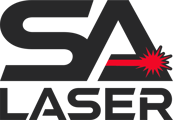Overview 5 Steps to Perfect Image Engravings
Achieving the perfect image engraving can be challenging, even for seasoned laser users. Common issues include images that appear too dark, too light, or lacking detail. This guide simplifies the process into five essential steps, helping you refine your laser settings for high-quality engravings.
Step 1: Optimize Focal Length
Purpose:
Focal length impacts the size and intensity of the laser dot on your material. A well-focused laser produces the smallest dot for maximum engraving precision.

How to Adjust:
- For Motorized Z-Axis:
Use Laser Tools → Focus Test in LightBurn. - For Non-Motorized Z-Axis:
Follow your machine manufacturer’s focusing instructions.
Pro Tip:
Start with a focused laser for consistency. Slightly defocusing the laser can soften edges between scan lines, but save this adjustment for the final step.
Step 2: Dial in Speed & Power
Purpose:
Speed and power determine the depth and darkness of the engraving.

How to Adjust:
- Run a test using Laser Tools → Material Test to find the ideal combination of speed and power.
- Apply the best values to a layer set to Image Mode in the Cut Settings Editor, or save them in the Material Library.
Pro Tip:
- CO2 Lasers: Perform better with slow speeds and low power for darker engravings.
- Diode Lasers: Achieve dark engravings more easily at higher speeds.
Step 3: Refine Line Interval/DPI
Purpose:
Line Interval (or DPI) controls the spacing between laser scan lines, impacting image darkness and clarity.

How to Adjust:
- Use Laser Tools → Material Test to find the ideal interval where lines touch without overlapping or leaving gaps.
- Typical settings range from 120 to 300 dpi (0.08-0.2 mm).
Pro Tip:
- Test perpendicular to the grain when working with materials like wood to avoid confusion with material texture.
- Use the same DPI for future projects to maintain consistency.
Step 4: Apply Dot Width Correction
Purpose:
Dot Width Correction adjusts for the natural thickness of the laser beam, ensuring accurate dot sizes in engravings.

How to Adjust:
- Use the Speed, Power, and Line Interval/DPI settings identified earlier.
- Configure the following in the Cut Settings Editor:
- Image Mode: Ordered
- Bi-Directional Scanning: Off
- Negative Image: Off
- Test with a 50% gray rectangle and experiment with Dot Width Correction values. These values should always be smaller than the Line Interval.
Pro Tip:
After testing, switch back to Jarvis Image Mode and re-enable Bi-Directional Scanning for faster engraving.
Step 5: Adjust the Image
Purpose:
If results are still unsatisfactory, the issue might lie in the image itself.
How to Adjust:
- Use the Adjust Image tool in LightBurn.
- Tweak settings like Brightness, Contrast, Gamma, and Enhance Features to refine the image.
